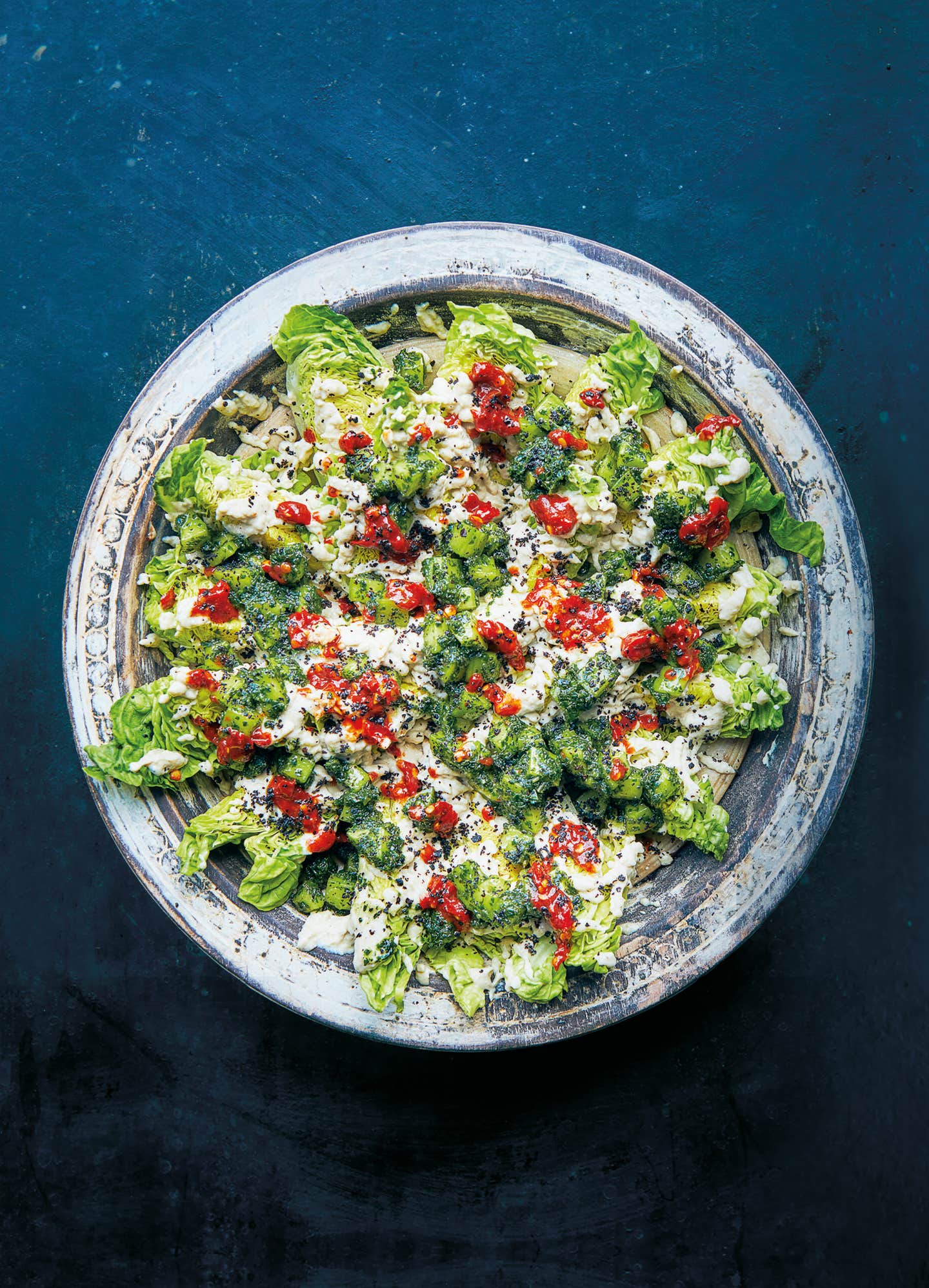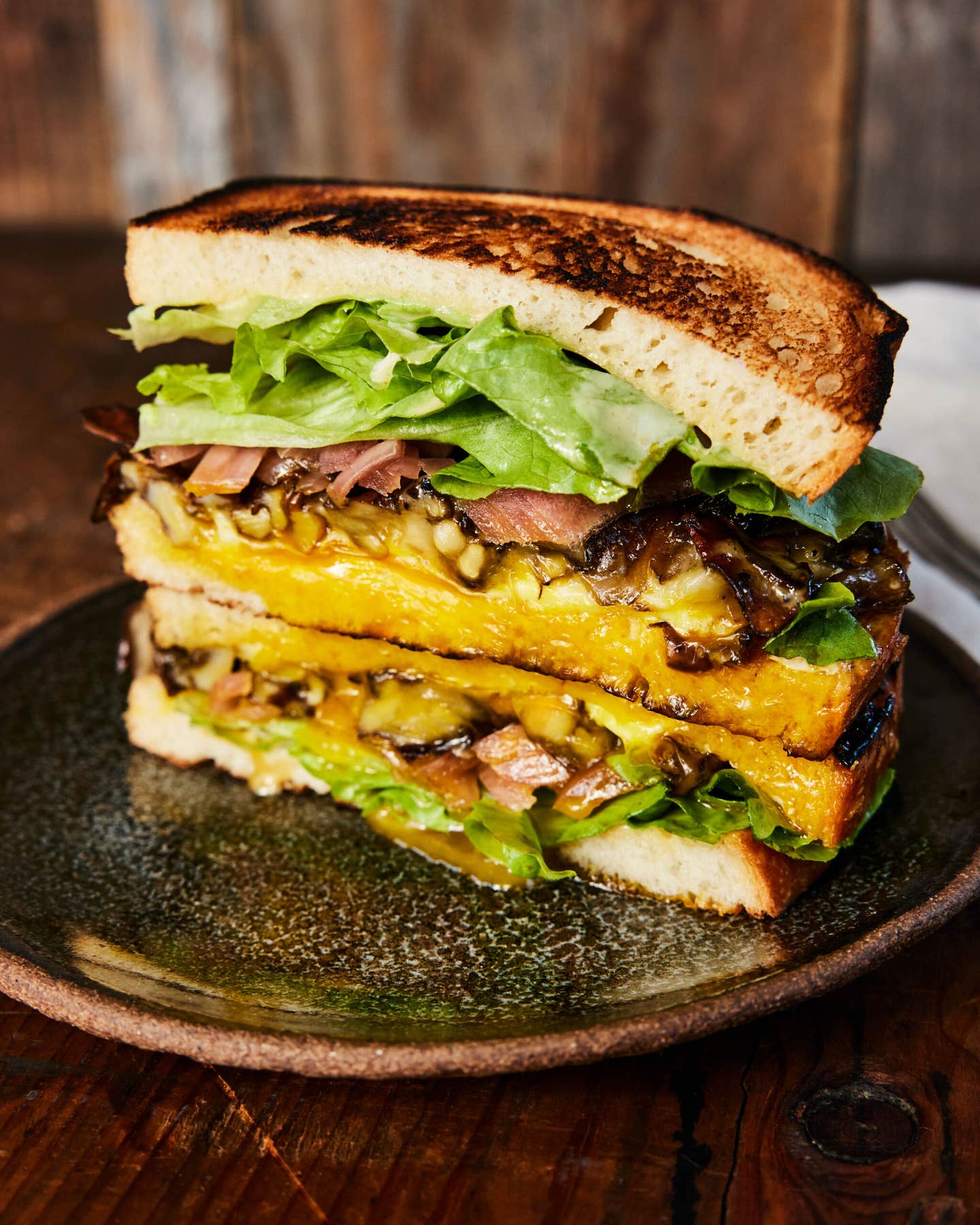‘Falastin’: Equal Parts Cookbook and Conversation Starter
Why Sami Tamimi and Tara Wigley think everybody should cook more Palestinian food

My copy of Jerusalem, by Sami Tamimi and Yotam Ottolenghi, is a mess. Flip through it and you’ll find oil blotches, desiccated plant matter, and pages stuck together with pomegranate molasses and other miscellaneous schmutz. Like many cooks, I consistently reach for this bible of modern Israeli and Palestinian cuisine.
So when I heard that Palestinian-born Tamimi and British food writer Tara Wigley were teaming up on a Palestinian cookbook called Falastin (Ten Speed Press, June 2020), I saw my next victim, tahini stains be damned.
Falastin, the October-November pick for the SAVEUR Cookbook Club, brings together Palestinian recipes both traditional and novel, from the za’atar-topped jammy eggs of Tamimi’s youth to a blissfully unorthodox labneh cheesecake heady with cardamom and orange blossom water. Containing well over 100 recipes, the book is a workhorse, more at home on the kitchen shelf than on the coffee table. Most of the recipes come together in under an hour.
Yet as with any book from the Ottolenghi restaurant empire (Tamimi co-owns and is executive chef of six London establishments alongside Yotam Ottolenghi), Falastin is also a looker. The photography is vivid and evocative, whether you’re staring at plump, ultra-flaky sambousek (Arabic samosas) or a serene portrait of a woman Tamimi and Wigley met in the Aida refugee camp, Islam Abu Aouda, whose recipe for ravioli-like shush barak graces the meat chapter.
Between whipping up recipes like squash-saffron soup or baked fish in tahini sauce, make time to ponder the essays interspersed throughout the book, which range in subject matter from Palestinian olive oil production to the fraught politics of the Gazan fishing industry. Combined with the recipes, they portray the Palestinian nation as relatable, human, and kind, a welcome departure from the gloom-and-doom narrative dominating the news cycle.
Last week, I caught up with Tamimi and Wigley on a video call to learn more about their new release.
BK: What are the defining flavors of Palestinian food, and how do they differ by region?
ST: Because Palestine is shrinking, everyone is cooking everyone else’s food, but there are still some regional differences. In Gaza, seafood and fish are everywhere. Bethlehem is known for its cheese and bread. Green chile, dill seeds, garlic, za’atar, sour pomegranate juice, burnt aubergine, cardamom, mint, lemon: These are the flavors I grew up with.
BK: What inspired you to write this book?
TW: Jerusalem was so well-received that it was time to zoom in on Palestine. A cookbook is such a good entry point into an area’s geography, history, and politics. We wanted to write recipes for cooks not living in Palestine, to make the cuisine more practical and approachable, and to bring people closer to Palestinian culture through its food.
ST: Falastin is a “thank you” to the country that I come from. I left Palestine 23 years ago, but it is the backbone of my cooking career. I wanted to share my heritage and its food and people with the world.
BK: What sets Falastin apart from other Palestinian cookbooks?
ST: Many Palestinian cookbooks focus on the same traditional dishes. We wanted to show modern Palestine without any nostalgia. People are living there, making incredible food right now, and it all ties back to their connection to the land.
TW: There’s also the fact that men don’t cook in Palestine, and this book was written by one!
BK: Tell me more about gender roles and cooking in Palestine.
ST: When I was little, I was always kicked out of the kitchen because I was told boys didn’t belong there. When I was 18 and decided to become a chef, my dad disapproved and said that it was a woman’s job. So to learn to cook Palestinian food, of course I have to rely on a lot of women. They are the keepers of the knowledge, passed down from mother to daughter.
BK: What surprised you most in researching this book?
TW: Coming from a rushed London world, I’m always surprised by anyone willing to give their time to a stranger. That happens often in Palestine. When you sit down to a four-hour lunch that your hosts started cooking the day before, it’s extremely humbling. It sounds silly, but I was unprepared for the amount of fun I had in Palestine, hanging out with locals, considering the grim backdrop one comes to expect.
BK: But that grim backdrop exists, right? One million people are facing hunger in Gaza currently, and the U.S. has cut hundreds of millions of dollars in aid in recent years.
ST: It’s not all gloomy. With Palestine, you get a lot of black and white messages, but there’s a lot of gray. You can’t rely on politicians to change minds—you have to go there, see the place, meet the people, eat the food. Palestinians aren’t sitting around crying about their situation. They’re switched on, helping one another, and trying to make things better for themselves. Everyone should learn about what’s going on there with an open mind. It’s not about taking sides.
TW: Despite the grim circumstances, Palestinians are hopeful and doing exciting, enterprising things with food. We give that contradiction space in the book. Words and recipes and stories are important, and we did not take that responsibility lightly. Some stories in Falastin are meant to be celebrated, while others are meant to sober people up. People always talk about the links between food and identity, but I didn’t fully get it until I spent time in Palestine. Chicken mussakhan is traditionally made with olive oil when it’s freshly pressed and abundant. So the fact that the olive trees are being threatened [by the construction of Israeli settlements] is also a threat to the culture. It’s all connected.
BK: When we’re able to travel normally again, do you recommend people visit Palestine?
TW: Yes! It’s not a massive region; you can see Bethlehem, Nazareth, and other key sights in a short amount of time.
ST: There’s lots to see if you know where to look. The problem is, most tourists are whisked out of Palestinian areas and not given a chance to engage with locals, which doesn’t help the country’s image. Amos Trust gives good culinary tours.
BK: What are your favorite dishes to cook from this book?
TW: I keep going back to the little gem salad [on the cover]. People start eating it politely, and then before you know it, everyone’s digging out the aubergine cream with abandon. Oh, and I always have a jar of shatta chile paste in the fridge.
ST: Chicken mussakhan is one of those magical, show-stopper things that doesn’t take long to make. It’s a spiced chicken, roasted till crispy with lots of caramelized red onion, sumac, olive oil, and pine nuts. Naan can even stand in for the traditional flatbread. Mussakhan embodies the Palestinian way of eating—everyone around the same plate, grabbing a bit of bread and chicken with your hands.
This interview has been edited and condensed for clarity.
Keep Reading
Continue to Next Story










